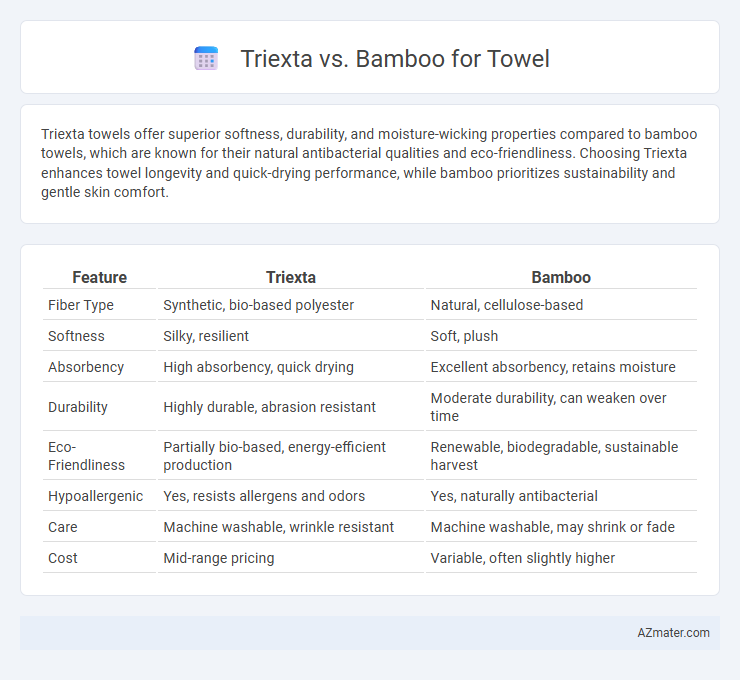Triexta towels offer superior softness, durability, and moisture-wicking properties compared to bamboo towels, which are known for their natural antibacterial qualities and eco-friendliness. Choosing Triexta enhances towel longevity and quick-drying performance, while bamboo prioritizes sustainability and gentle skin comfort.
Table of Comparison
| Feature | Triexta | Bamboo |
|---|---|---|
| Fiber Type | Synthetic, bio-based polyester | Natural, cellulose-based |
| Softness | Silky, resilient | Soft, plush |
| Absorbency | High absorbency, quick drying | Excellent absorbency, retains moisture |
| Durability | Highly durable, abrasion resistant | Moderate durability, can weaken over time |
| Eco-Friendliness | Partially bio-based, energy-efficient production | Renewable, biodegradable, sustainable harvest |
| Hypoallergenic | Yes, resists allergens and odors | Yes, naturally antibacterial |
| Care | Machine washable, wrinkle resistant | Machine washable, may shrink or fade |
| Cost | Mid-range pricing | Variable, often slightly higher |
Introduction to Triexta and Bamboo Towels
Triexta towels are made from a resilient synthetic fiber derived from corn sugar, offering exceptional softness, durability, and moisture-wicking properties ideal for quick drying. Bamboo towels utilize natural bamboo fibers known for their antibacterial qualities, eco-friendliness, and high absorbency, providing a soft and sustainable option for bath linens. Both materials present unique benefits, with Triexta excelling in long-lasting softness and bamboo standing out for its natural antimicrobial features and environmental sustainability.
Material Source and Sustainability
Triexta towels are made from renewable plant-based materials derived from corn sugar, offering significant biodegradability and reduced carbon footprint compared to traditional synthetics. Bamboo towels stem from fast-growing bamboo grass, which requires minimal water and pesticides, making it a highly sustainable resource with natural antimicrobial properties. Both materials prioritize eco-friendly production, but Triexta emphasizes biobased polymers, while bamboo highlights natural fiber renewability and minimal environmental impact.
Softness and Comfort Comparison
Triexta fibers provide exceptional softness and durability, making towels plush and comfortable for everyday use. Bamboo towels offer natural moisture-wicking properties and a silky texture, enhancing comfort while being eco-friendly. When comparing softness and comfort, Triexta towels tend to retain their plush feel longer, whereas bamboo towels excel in breathability and gentle skin touch.
Absorbency and Drying Performance
Triexta fibers outperform bamboo in towel absorbency due to their moisture-wicking properties and fine fiber structure, enabling faster water retention. Bamboo towels exhibit moderate absorbency but excel in quick drying because of their natural breathability and antimicrobial characteristics. When balancing absorbency and drying performance, Triexta towels offer superior moisture management, while bamboo towels provide enhanced freshness and quicker drying cycles.
Durability and Longevity
Triexta towels exhibit superior durability due to their inherent stain resistance and elasticity, making them less prone to wear and tear over time. Bamboo towels offer natural antibacterial properties and a soft texture, but they tend to lose strength and degrade faster after multiple washes. For longevity, Triexta fibers retain their shape and color longer, ensuring sustained performance in high-usage environments.
Eco-Friendliness and Biodegradability
Triexta towels offer excellent eco-friendliness due to their renewable sugar-based fibers and significant durability, reducing waste through longer use cycles. Bamboo towels are highly biodegradable and naturally antimicrobial, decomposing faster in compost environments, which minimizes landfill impact. Comparing the two, Triexta's production has a lower carbon footprint, while bamboo's rapid biodegradability ensures quicker environmental reintegration, making both sustainable yet distinct choices for eco-conscious consumers.
Maintenance and Care Requirements
Triexta towels offer exceptional durability with stain-resistant and quick-drying properties, requiring minimal washing frequency and gentle machine cycles to maintain softness. Bamboo towels are naturally antimicrobial and highly absorbent, demanding cold water washes and air drying to preserve fiber integrity and prevent shrinkage. Both materials benefit from avoiding fabric softeners and high heat, but Triexta's synthetic origin typically allows for easier upkeep and longer-lasting freshness compared to bamboo's eco-friendly yet more delicate care needs.
Allergies and Skin Sensitivity
Triexta fibers offer excellent hypoallergenic properties, making towels highly suitable for individuals with allergies and sensitive skin. Bamboo towels naturally resist bacteria and mold due to their antimicrobial properties, reducing irritants for sensitive skin. Both materials provide gentle, breathable textures that minimize skin irritation, but Triexta's synthetic origin ensures consistent softness without chemical residues.
Cost and Value for Money
Triexta towels generally cost more than bamboo towels due to their innovative polymer fiber offering superior durability and stain resistance. Bamboo towels tend to be more affordable but may wear out faster and require more frequent replacement. When evaluating value for money, Triexta towels provide longer lifespan and better performance despite the higher upfront cost, making them a cost-effective choice over time.
Choosing the Best Towel: Triexta vs Bamboo
Triexta towels offer exceptional softness, durability, and stain resistance due to their synthetic fiber composition, making them ideal for long-lasting use and easy maintenance. Bamboo towels provide natural antibacterial properties, excellent moisture-wicking, and eco-friendly benefits, appealing to those seeking sustainable and hypoallergenic options. When choosing the best towel, consider whether durability and ease of care take priority, favoring Triexta, or if environmental impact and natural softness are more important, highlighting bamboo as the optimal choice.

Infographic: Triexta vs Bamboo for Towel
 azmater.com
azmater.com